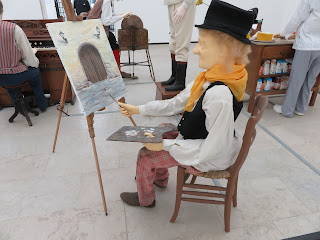Of the many engaging works in the second stage of May You Live in Interesting Times, I single out two that reverberated for me. Teresa Margolles's Muro Ciudad Juarez, 2010, a wall transported from that city, with its razor wiring, graffiti and bullet holes, spoke to the drug violence in Mexico more emphatically than any video I can recall.
And again I was taken by Jimmie Durham. This time his work is a slab of Black Serpentine, 2019, accompanied by a panel that puts the work in the context of global commerce.
I thought the Russian Pavilion's installation based on Rembrandt's Prodigal Son was overblown and so dark I was afraid I would fall. It made me feel sorry for the painting.
The videos of indigenous people in the Canada Pavilion addressed issues of land and cultural appropriation.

The German Pavilion again was reconstructed in a way that made little impact.
We had some discussions with the guides in the Great Britain installation, who told us the artist, Cathy Wilkes, didn't want them to explain the work, that we should understand it in our own way. Honestly, I tried and I didn't.
I enjoyed exploring the reconceived tomb that was the Egyptian Pavilion, "khnum across times witness."
I also found the inside-out airplane in the Polish Pavilion fascinating.
The Belgian Pavilion "Mondo Cane" by Jos de Gruyter and Harald Thys, was a sort of diorama of puppets portraying craftspeople in the center area and zombies and misfits behind bars on the periphery.
I wonder about the interpretation of the monumental façade that sits in front of the building, a sort of flat light-colored trellis supported by a heavy black twisting form. The light part, a circle with rays curving away from it suggests classical architectural designs, and the twisting black support is in strong contrast to it, so the idea that this is elegant white America supported by black labor makes sense, especially after reading the NY Times's 1619 Project essays. (Incidentally, my Spalding ancestor arrived in Jamestown in April 1619, just a few months before those first slaves. I believe my ancestor was an indentured servant and I would be surprised if he could have afforded slaves. By 1627 he had completed his indentureship and in 1634 he moved to Braintree, Massachusetts. Regardless, he must have witnessed the beginning of slavery in America.
The Wall Street Journal did not discuss at least one work, the large red curved shape that I thought looked sort of like a cap. It's titled Big Phrygian and dates from 2010-14, painted red cedar. In the seventeenth century Phrygian caps were a symbol of liberty and an article on this work says that Puryear saw a print of an African American wearing a Phrygian cap, the source for this sculpture. I had no idea of that background in the exhibition, just thought the sculpture was an interesting minimal shape. And I wonder how many visitors to the exhibition would have known this story.
Most impressive to me is the central sculpture, a tribute to Sally Hemmings, positioned under the dome of the pavilion entrance, the most Jeffersonian part of the very neoclassical pavilion. It's a tall white pedestal topped by a metal form that suggests a cross and a shackle.














